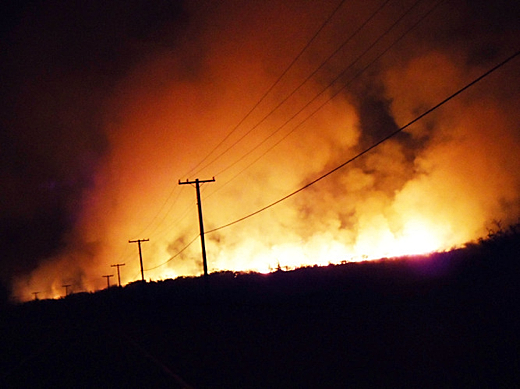SUBHEAD: There is trouble in paradise. Hawaii is suffering through a historic drought. Is this our climate change?
Image above: Fire along Honoapiilani Highway on Maui this summer. From article.
By NPR Staff on 1 September 2010 for Morning Edition -
Hawaii is suffering through an unprecedented drought — El Nino conditions in the Pacific have added new misery to a half-century of declining rainfall on the tropical island chain. A two-year dry spell has fueled wildfires and destroyed crops from Oahu to the Big Island.
Big Island resident Judy Hancock recalls the day a month ago that she told her husband that a nearby road, full of dry trees and plants, was at risk for a fire.
Soon after that dinner-table conversation, wildfire broke out.
"It's so dry that it was just explosive, almost, you know. I mean, the fire just took off like mad," Hancock says.
Today, her lush green front yard stands in contrast to the dry and charred land surrounding it. Miraculously, the fire in late July stopped short of her home, at a stone wall about 100 yards away. The couple's home is atop Mount Kohala, on the northern tip of the island.
The entire state of Hawaii is dry. But the Big Island, about 160 miles southeast of Honolulu, is ground zero for the drought. Kevin Kodama, a hydrologist for the National Weather Service, says that some swaths of the Big Island are the driest places in the United States.
"They were on pace to set all-time records for the driest year ever," he says. "And you're talking about stations that have over 50 years of record. So this is very unusual."
It's also very costly — especially for the up to 60,000 people in Hawaii who depend on rain for their fresh water.
Robin Lamson, who lives on the southern tip of the Big Island, has a 20,000-gallon steel-sided catchment tank in his backyard. Banging on the side of the tank, he says he has about a quarter of a tank left.
Lamson estimates that he's spent $600 more this year paying water haulers to fill his tank. He says that while this part of the island has always been relatively dry, "we have not had more than 2 inches of rain in nine months, and that's been a little sprinkle at a time — an eighth of an inch, maybe."
South Kona coffee grower Jason Stith says he is seriously considering a loan, to help him cope with the conditions.The trees around his house are dying now, Lamson says. And Hawaii's crops are dying too: The entire state has been designated an agricultural disaster area by the federal government, enabling farmers to apply for special loans.
Pulling on a branch from a coffee tree growing out of rocky volcanic soil, Stith points out how the beans are suffering from a lack of water. "They don't have a lot of mucilage or juice in them — they're dry," he says. "They should be full and plump, and they just aren't. You can see it even in the green cherry."
The ocean twinkles off in the distance. Despite this serene location, Stith says he felt depressed after picking coffee on a recent day. He estimates that 50 percent of the crop has been damaged by the drought.
"I'm just amazed that they hang on at all," he said, before adding, with a touch of gallows humor, "I think it's the caffeine in the coffee that keeps 'em going."
The pain of the drought isn't just felt on the Big Island. Wildfires have charred parts of Maui. And on the east side of Oahu, mandatory water restrictions are in effect, thanks to a critically low reservoir.
Relief for that problem — and for Hawaii's residents — is still months away: The rainy season doesn't officially start until November.
See also:
.

No comments :
Post a Comment